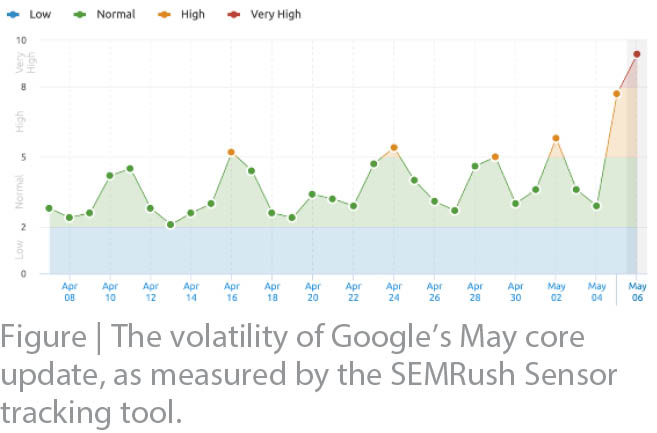When it comes to search engine optimization (SEO) and health care, only two statistics matter:
1. More than eight out of 10 patients use Google as their first step in researching a medical condition or selecting a physician1; and
2. Fewer than one in 100 patients will ever click through to page 2 (or beyond) of Google search results.2
A practice’s ability to appear high in organic search engine results pages is crucial for patient acquisition and growth. If your practice website does not appear on page 1, you’re missing out on patients and revenue. But Google is notorious for changing its algorithms. In 2018 alone, the company made 3,234 changes to its algorithm, for an average of almost nine changes per day.
To help physicians and their marketing managers stay on top of the biggest developments in SEO, this article summarizes the major changes that occurred this quarter. Included are actionable tips and insights that practices can take to respond to market changes, stay on top of their online presence, and keep acquiring patients from organic search.
MAY 2020 CORE UPDATE
What Happened
On May 4, Google announced the release of a core update to its algorithm. Although most algorithm changes are minor, core updates are large and happen only three or four times a year. The May core update was a monster: It took more than 2 weeks to finish rolling out and had a huge impact on the rankings of many websites. Figure 1 shows the volatility of this update, as measured by the SEMRush Sensor tracking tool.
Why It Matters for Health Care
Although previous core updates have focused on specific industries, this update was broad and did not target any particular industry. However, health care is categorized in the Your Money or Your Life (YMYL) space. YMYL websites are those whose content, if presented inaccurately or deceptively, could have an outsize impact on the reader’s happiness, health, safety, or financial stability. Google holds YMYL websites to a higher standard than others, so we usually see more volatility with health care websites when a core update comes along.

Figure | The volatility of Google’s May core update, as measured by the SEMRush Sensor tracking tool.
What Practices Should Do
Check Google Search Console and Google Analytics to determine if your website has been hit by a core update. This will inform your strategy and next steps. Additionally, perform an audit of Google’s expertise, authoritativeness, and trustworthiness (E-A-T) signals across the internet. What is being said about your practice, physicians, and content elsewhere online? Are there any areas that portray a less-than-stellar reputation?
Remember, if your website was hit hard by a core update, it doesn’t mean that the website or its content is bad—it just means that Google has found content that it considers better than yours. There may be ways you can improve your on-page experience, E-A-T, and other factors, but you don’t necessarily need to throw everything out the window.
GOOGLE TO USE PAGE EXPERIENCE FACTORS AS RANKING SIGNALS
What Happened
On May 28, Google announced that it will consider page experience factors as ranking signals, beginning in 2021. Among these factors are Core Web Vitals, which measure three aspects of a website:
1. Largest Contentful Paint, or how long it takes a page to fully load;
2. First Input Delay, or how long it takes a page to become interactive; and
3. Cumulative Layout Shift, or visual stability and any unexpected layout shifts that happen as a page loads.
Why It Matters for Health Care
Any time Google explicitly announces a new ranking factor, doctors should pay attention. Many practice websites aren’t fully optimized for lightning-fast load times. Even more practice websites pull content (such as explainer videos and appointment booking modals) in from third-party sources, which can cause layout shifts and delays in page interactivity. Not only is this bad for patient experience, but moving forward, offending websites might find themselves ranking lower on Google as a result.
What Practices Should Do
This announcement is a major event, as Google’s algorithms are a closely held secret, and the company rarely confirms any ranking factors. However, there is no immediate need to take action. Google has noted that this change will not take place before 2021, and webmasters will have at least 6 months’ notice to implement any needed changes.
If you want to get ahead of the curve, audit your website for these Core Web Vitals using Google’s Core Web Vitals Chrome extension. Switch to dedicated hosting or consider using a content delivery network to improve site load times and take advantage of caching features. This will help your practice website load faster, provide better patient experience, and rank higher on Google.
DELAY IN MOBILE-FIRST INDEXING
What Happened
In March, Google announced that it would switch all websites on the internet over to mobile-first indexing by September 2020. Mobile-first indexing means that Google will crawl your website from the eyes of a mobile browser and use that mobile version for indexing and ranking—so, if your website isn’t easy to use on a mobile device, you could see lower rankings.
However, due to COVID-19 interruptions, the timeline for this switch has been extended. The company has indicated that the transition will now take between 6 and 12 months, meaning that it will happen sometime between September 2020 and March 2021.
Why It Matters for Health Care
As of 2018, 52% of all internet traffic comes from mobile devices. Google has recognized this tectonic shift and is using a mobile-first bot to crawl and index sites. If your website isn’t optimized for mobile devices, not only will patient experience suffer but Google will also penalize your online visibility. Not being mobile-first and mobile-friendly has a real impact on the bottom line for a practice, so spending the time and energy on getting your mobile website right is a worthwhile investment that can pay big dividends.
What Practices Should Do
Practices may now have a little more time on their hands to audit their websites and ensure mobile indexing compliance—use it wisely! If your website has separate mobile and desktop versions, that’s a huge red flag and the first priority should be to consolidate the two into one. Otherwise, Google’s switch to mobile-first indexing will cause your traffic from organic search to drop. This is most common for websites that were built before 2015.
Additionally, use Google Search Console to check for mobile errors. If Google encounters any problems when crawling your website, they will appear here. This is perhaps the best source of truth for uncovering issues. Run a page speed test on GTmetrix to analyze your website’s speed performance. Speed is a major component of Google’s algorithm these days, particularly on mobile devices. If your mobile website isn’t loading quickly, you will be penalized with lower rankings.
Google Analytics can be used to determine what percentage of your website’s traffic comes from mobile devices. Although there is nothing you can do about Google’s mobile-first indexing switch, checking your analytics can provide insights into user experience.
MOVING FORWARD
Change is the only constant in the SEO world, and these changes can be difficult to navigate. As Google seeks to improve the experience and the results it surfaces for its 1.7 billion daily active users, health care professionals must stay on top of these changes and adapt to continue serving their patients and growing their practices. Hopefully this Quarterly SEO Roundup will help.
1. Weaver J. More people search for health online. NBC News. July 16, 2020. http://www.nbcnews.com/id/3077086/t/more-people-search-health-online/%23.Xvn216dh1pQ#.Xyq7sRNKg3F. Accessed July 20, 2020.
2. Dean B. We analyzed 5 million Google search results: here’s what we learned about organic click-through rate. Backlinko. August 27, 2019. https://backlinko.com/google-ctr-stats. Accessed July 20, 2020.



